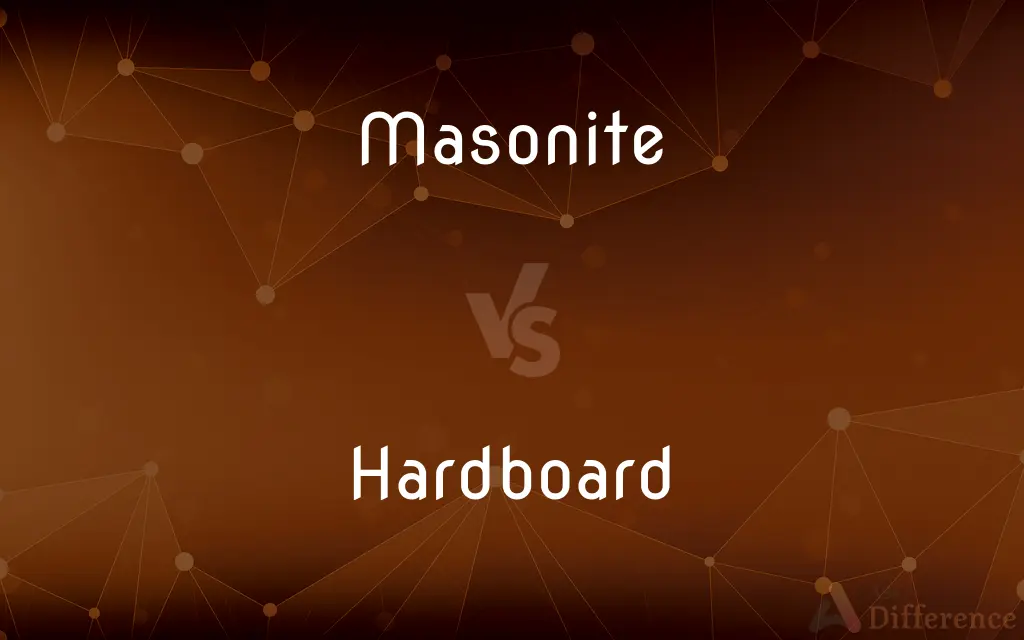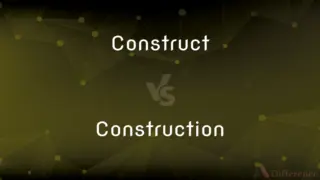Masonite vs. Hardboard — What's the Difference?
By Tayyaba Rehman & Fiza Rafique — Updated on April 6, 2024
Masonite is a type of hardboard known for its smooth finish and durability, often used in construction and furniture, whereas hardboard is a generic term for engineered wood panels of various types, including Masonite.

Difference Between Masonite and Hardboard
Table of Contents
ADVERTISEMENT
Key Differences
Masonite is a brand of hardboard, a type of engineered wood product that is made by pressing wood fibers together under high heat and pressure. It is known for its durability and smooth surface, making it ideal for use in construction and furniture-making. On the other hand, hardboard refers to a broader category of similar engineered wood products that can vary in quality, density, and manufacturing process. Hardboard is used for a variety of applications, from floor underlayment to cabinet backing.
While Masonite is specifically engineered for high durability and a smoother finish, often making it a preferred choice for more refined applications, such as interior design and high-end furniture, hardboard in general may not always meet the same quality standards. This can make generic hardboard more suitable for less visible or less critical applications, such as in construction where it will be covered by other materials.
Masonite's manufacturing process involves using steam and pressure to create a dense, uniform board, which results in a product that is resistant to warping and cracking. In contrast, the production of other hardboards can vary, with some manufacturers using a wet process that might result in a less dense and potentially less durable board.
Because of its high quality, Masonite often comes at a higher price point compared to generic hardboard. This cost difference makes Masonite a preferred option for projects where longevity and aesthetics are key, whereas hardboard may be chosen for more budget-conscious projects where these factors are less critical.
Despite their differences, both Masonite and hardboard offer a smooth surface that is ideal for painting or applying veneers, making them versatile materials in both residential and commercial construction. The choice between them often comes down to the specific requirements of the project and the budget constraints.
ADVERTISEMENT
Comparison Chart
Brand vs. Type
A specific brand
A generic type of engineered wood
Finish and Durability
Known for a smooth finish and high durability
Varies in quality and durability
Manufacturing Process
Uses steam and pressure for density and uniformity
Manufacturing processes vary
Price
Generally more expensive
More budget-friendly
Ideal Use
Preferred for high-end furniture and interior design
Suited for a wide range of applications, including construction
Compare with Definitions
Masonite
A brand of hardboard made by pressing wood fibers under high heat and pressure, known for its smooth surface and durability.
The interior designer chose Masonite for the cabinet doors to ensure a smooth, paintable surface.
Hardboard
Hardboard offers a smooth surface for painting or applying veneers, although it may not be as durable as Masonite.
The hardboard provided a smooth base for the mural, even though it was less expensive than Masonite.
Masonite
It is resistant to warping and cracking, making it ideal for high-quality applications.
The artist preferred Masonite for his paintings because it doesn't warp like canvas.
Hardboard
Suitable for a variety of applications, from construction to furniture backing.
We chose hardboard for the back panels of the wardrobes to keep costs down.
Masonite
Masonite is often used in construction and furniture-making due to its strength and aesthetic appeal.
Masonite panels were selected for the construction project for their superior durability.
Hardboard
A generic term for a dense engineered wood product made by compressing wood fibers.
The contractor used hardboard as a cost-effective solution for the floor underlayment.
Masonite
Masonite's smooth finish makes it an excellent choice for painting or veneering.
We used Masonite for the shelves because it paints up beautifully.
Hardboard
The quality and durability of hardboard can vary depending on the manufacturer.
We sourced high-density hardboard for the project to ensure durability.
Masonite
Despite its higher price, Masonite's quality and finish justify the cost for many applications.
Although Masonite was more expensive, its longevity made it a cost-effective choice for the home renovation.
Hardboard
It is a more budget-friendly option compared to Masonite, making it popular for various projects.
To stay within budget, we opted for hardboard over Masonite for the utility room shelves.
Masonite
Masonite is a type of hardboard, a kind of engineered wood, which is made of steam-cooked and pressure-molded wood fibers in a process patented by William H. Mason. It is also called Quartrboard, Isorel, hernit, karlit, torex, treetex, and pressboard.
Hardboard
Hardboard, also called high-density fiberboard (HDF), is a type of fiberboard, which is an engineered wood product. It is used in furniture and in the construction industry.
Masonite
A type of hardboard formed using wooden chips and blasting them into long fibers with steam and then forming them into boards.
Hardboard
A construction board made by compressing fibers of wood chips usually with a binder at a high temperature.
Masonite
A type of fiberboard.
Hardboard
A high-density chipboard.
Masonite
A type of fiberboard
Hardboard
A cheap hard material made from wood chips that are pressed together and bound with synthetic resin to form sheets, used in construction and various other purposes; - called also particle board and chipboard.
Hardboard
A cheap hard material made from wood chips that are pressed together and bound with synthetic resin
Common Curiosities
Where is Masonite commonly used?
Masonite is commonly used in high-end furniture, interior design, and anywhere a durable, smooth surface is desired.
What is Masonite?
Masonite is a brand of hardboard known for its smooth surface and durability, made by pressing wood fibers under high heat and pressure.
Can you paint on Masonite and hardboard?
Yes, both Masonite and hardboard provide smooth surfaces ideal for painting.
Are there different types of hardboard?
Yes, hardboard comes in various types, including those with different densities and finishes, depending on the manufacturing process.
Is Masonite more expensive than hardboard?
Yes, Masonite is generally more expensive than generic hardboard due to its higher quality and durability.
What is hardboard?
Hardboard is a type of engineered wood made by compressing wood fibers, known for its versatility and wide range of applications.
Is Masonite environmentally friendly?
Masonite and hardboard products vary in their environmental impact, depending on the manufacturing process and materials used.
Can hardboard be used outdoors?
Hardboard is generally not recommended for outdoor use unless it is specially treated for moisture resistance.
How does Masonite differ from generic hardboard?
Masonite is specifically known for its high quality, durability, and smooth finish, whereas the quality of hardboard can vary.
What makes Masonite resistant to warping and cracking?
Masonite's manufacturing process, involving high heat and pressure, makes it dense and uniform, thus resistant to warping and cracking.
Can hardboard be used for flooring?
Yes, hardboard can be used as a floor underlayment due to its smooth surface and stability.
How is hardboard manufactured?
Hardboard is manufactured by compressing wood fibers with heat and pressure; the specifics can vary by manufacturer.
What are common uses of hardboard?
Common uses include floor underlayment, furniture backing, and construction panels.
Why choose Masonite over hardboard?
Masonite is chosen for applications where durability, smooth finish, and aesthetic appeal are crucial.
How do you cut Masonite or hardboard?
Both can be cut with standard woodworking tools, but care should be taken to avoid splintering or damage.
Share Your Discovery

Previous Comparison
Sterilization vs. Sterilisation
Next Comparison
Construct vs. ConstructionAuthor Spotlight
Written by
Tayyaba RehmanTayyaba Rehman is a distinguished writer, currently serving as a primary contributor to askdifference.com. As a researcher in semantics and etymology, Tayyaba's passion for the complexity of languages and their distinctions has found a perfect home on the platform. Tayyaba delves into the intricacies of language, distinguishing between commonly confused words and phrases, thereby providing clarity for readers worldwide.
Co-written by
Fiza RafiqueFiza Rafique is a skilled content writer at AskDifference.com, where she meticulously refines and enhances written pieces. Drawing from her vast editorial expertise, Fiza ensures clarity, accuracy, and precision in every article. Passionate about language, she continually seeks to elevate the quality of content for readers worldwide.
















































